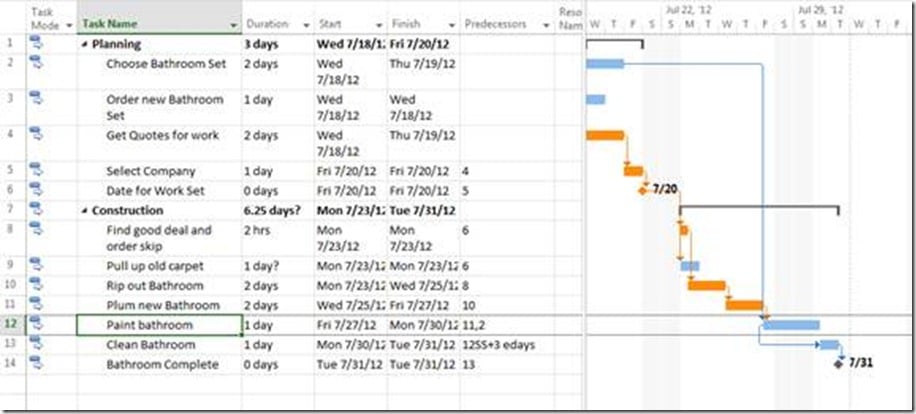This is the first in a series of Blogs that will briefly cover some of the new features of Microsoft’s latest release of Project; Project 2013. The Highlight Task Path Feature One of the most obvious new features to Project 13 is located in the ‘Format’ Ribbon. It is called the ‘Highlight Task Path Feature’. This feature highlights tasks that are linked to a selected task. This allows you to see how the selected task fits into the overall project. The benefit of this feature is that it allows you to, at a glance, see which tasks will be affected prior to making changes to your schedule. It’s a similar concept to the ‘Change Highlighting’ that was introduced in Project 2010.
There are 4 types of Task Path Highlighting (As Below)
How do the different types of Highlighting work? Predecessors Highlighting To use this function you would first select ‘Predecessors’ highlighting from the ‘Bar Styles‘ section from the ‘Format’ ribbon. You would then click on the task name of the Task in which you want to see the ‘Predecessors’. In this Example I have selected ‘Clean Bathroom’. With ‘Predecessor’ highlighting switched on; you can see all the tasks that are a predecessor of the task highlighted in light yellow. Note: The Task; ‘Pull up old carpet’ is not highlighted as ‘Clean Bathroom’ and indeed no tasks are dependent on ‘Pull up old carpet’ as this can be done at any time after the Milestone ‘Date for Work Set’ is complete.
Driving Predecessors Highlighting Similar to ‘Predecessors’ highlighting, ‘Driving Predecessors’ highlighting will highlight just the predecessor tasks that directly affect a selected Task.
To explain; we might what to match the paint that we buy, with the color of the bathroom set. So to do this, I will link the task ‘Paint bathroom’ to ‘Choose Bathroom Set’ making ‘Choose Bathroom Set’ a predecessor. As you can see ‘Choose Bathroom Set’ is clearly a predecessor, however because its’ completion date is not “critical” to ‘Paint bathroom’ there is a lag before ‘Paint bathroom’ is scheduled to start. To further clarify; should ‘Choose Bathroom Set’ take longer than planned; eliminating the “lag” between the two tasks; ‘Choose Bathroom Set’ would then become a “Driving Predecessor” as below:
Successors Highlighting This will highlight successors of a selected task. In this example I have selected ‘Find good deal and order skip’ with ‘Successors’ highlighting switched on; you can see all the tasks that are a successor of the task highlighted in light purple.
Driven Successors Highlighting This will highlight successors that are directly affected by the selected task. You may be thinking; any task that is a successor is going to be directly affected, so what’s the difference? Or you may be thinking; ‘Driven Successors’ highlighting would only highlight tasks that are a successor and on the “Critical Path”. Well you would be correct in both instances. The only way we would ever see a difference between ‘Driven Successors’ and ‘Successors’ highlighting is when you have a “Constraint” set on a task . Constraints override Project’s scheduling engine, they move a tasks regardless of their predecessors. As Below:






![clip_image002[9]](https://blog.epmainc.com/wp-content/uploads/clip_image0029_thumb.jpg)
![clip_image002[12]](https://blog.epmainc.com/wp-content/uploads/clip_image00212_thumb.jpg)
